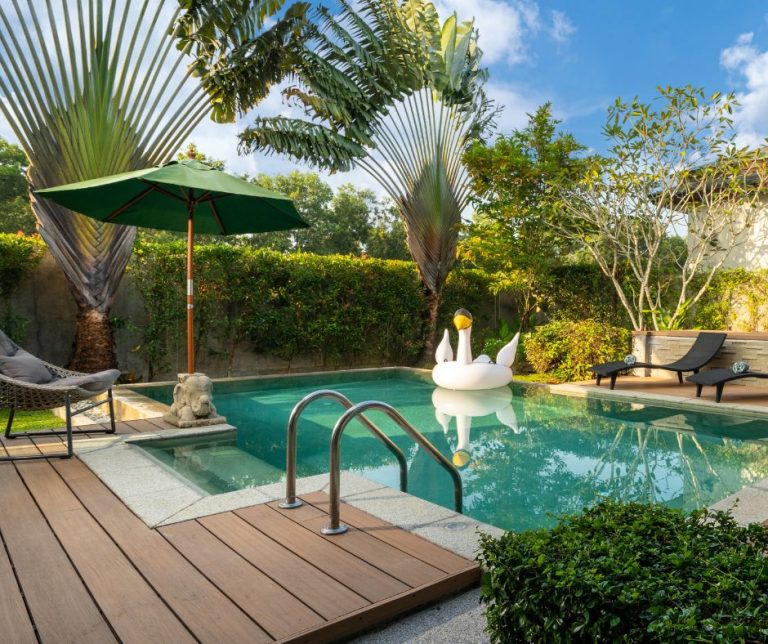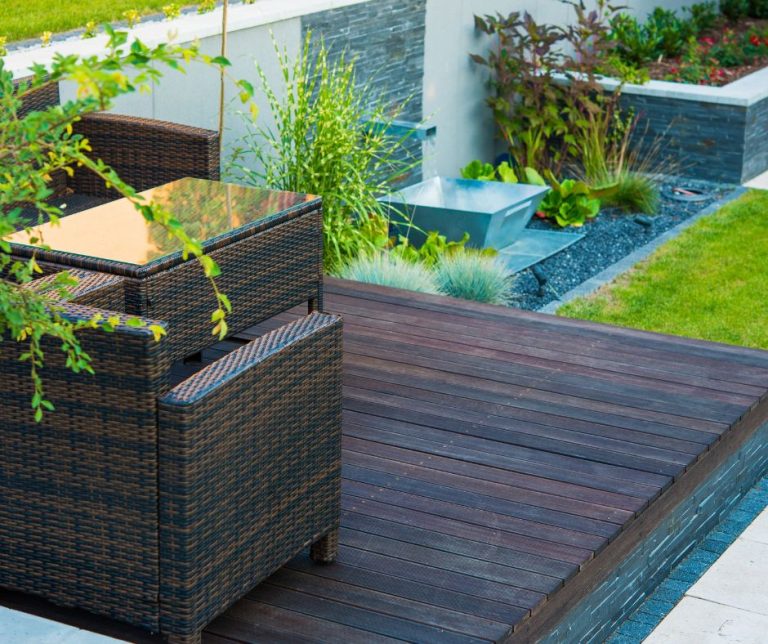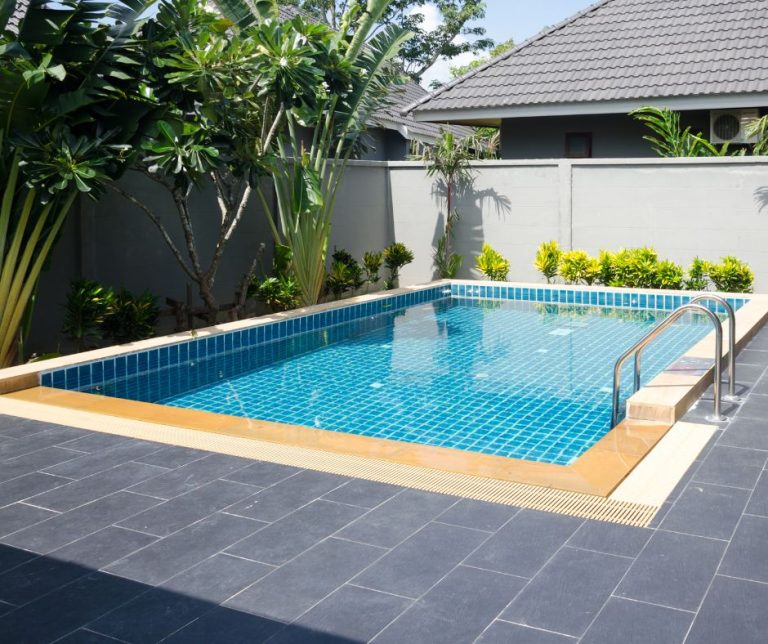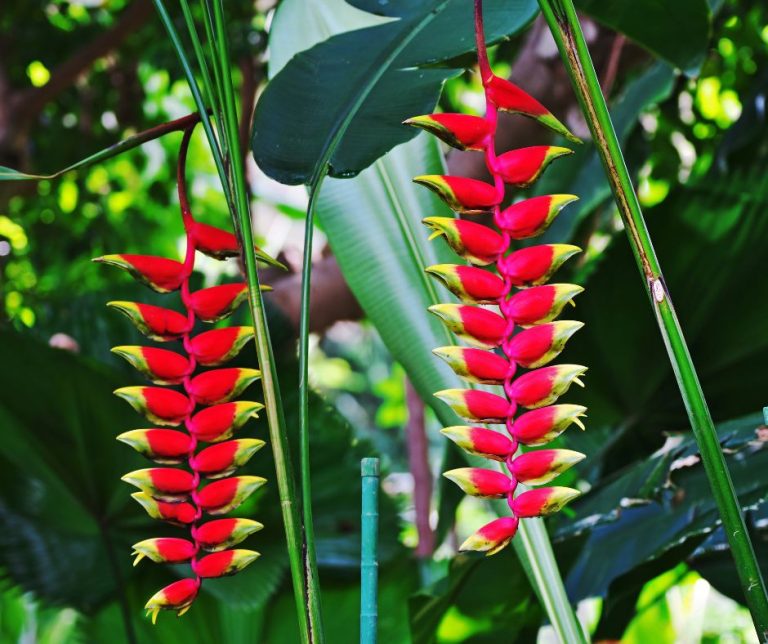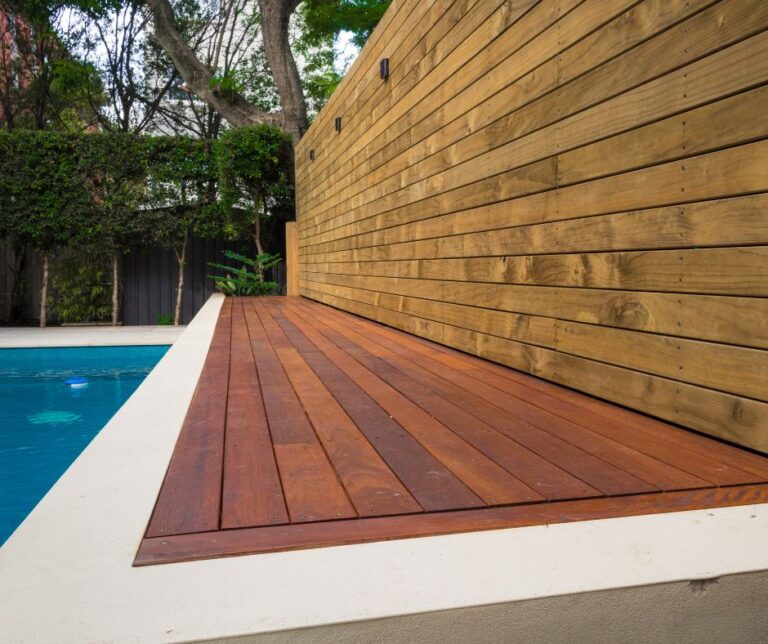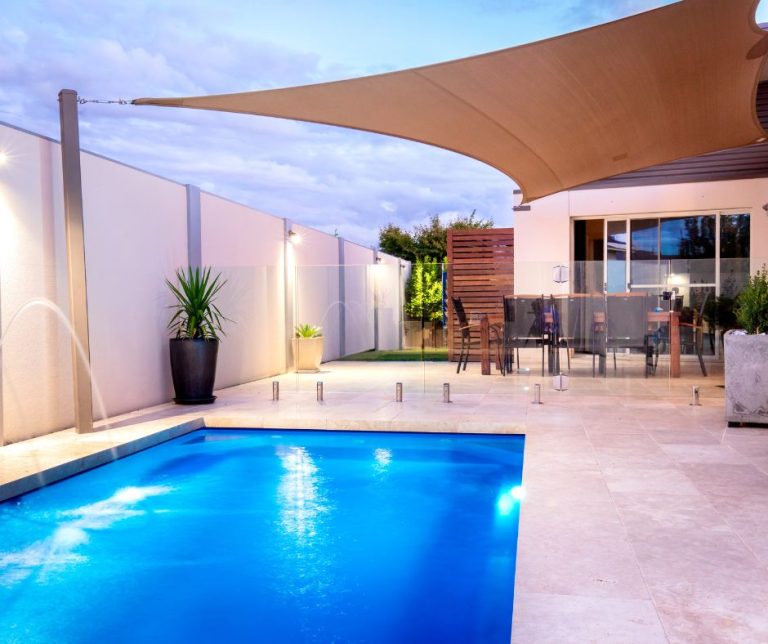Selecting The Perfect Surface For Your Pool Surround
Enhancing Your Swimming Pool Area
Creating a stunning pool area goes beyond just the pool itself.
Pool surrounds play a crucial role in enhancing the overall aesthetics and functionality of your outdoor space. Whether you’re designing a new pool area or revamping an existing one, selecting the perfect materials for your pool surrounds is essential.
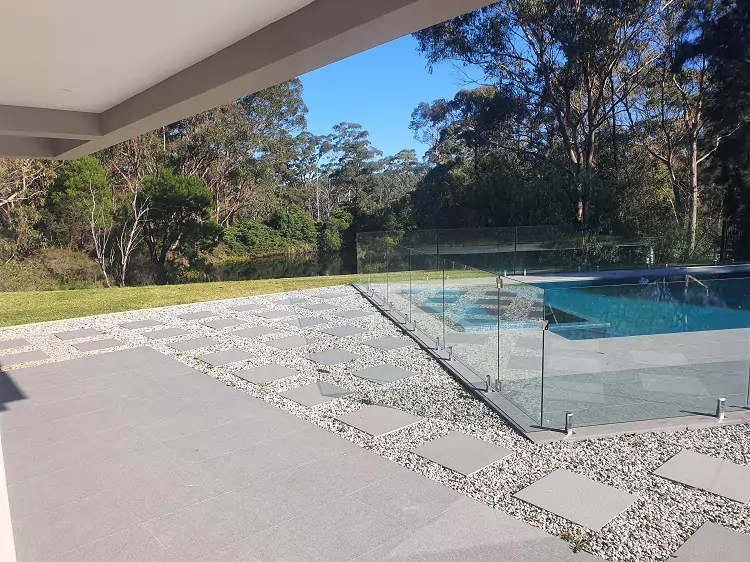
Importance of Pool Surrounds
They provide a safe and comfortable surface for walking, lounging, and enjoying the pool area.
The right pool surrounds can also transform your outdoor space into a luxurious oasis, adding value to your property.
The choice of materials, colors, and textures can create a cohesive design that complements the surrounding landscape and architectural style of your home.
And there is no rule that says you must use the same material around the entire pool.
Many of our clients will add different areas.
They may have a small timer deck and pergola section at one end of the pool and pavers or stamped concrete elsewhere around the pool.
We often install artificial turf around pools and this looks great when there is a garden area near the pool as maintaining a lawn around is not always practical
Factors to Consider When Choosing Materials
When selecting materials for your pool surrounds, it’s important to consider various factors to ensure the best fit for your needs. Here are a few key considerations to keep in mind:
- Durability: Pool surrounds are exposed to constant moisture, sunlight, and foot traffic. Therefore, durability is crucial. Look for materials that are resistant to water damage, fading, and wear and tear.
- Slip Resistance: Safety is paramount, especially around a wet area like a pool. Choose materials that provide adequate slip resistance to minimize the risk of accidents.
- Heat Reflectivity: Pool surrounds can become hot under direct sunlight. Opt for materials with higher heat reflectivity to keep the surface cooler and more comfortable for bare feet.
- Maintenance: Consider the level of maintenance required for the materials you choose. Some materials may require regular sealing, cleaning, or repairs, while others are relatively low maintenance. Take into account your desired level of upkeep.
- Aesthetics: Your pool surrounds should complement the overall design aesthetic of your outdoor space. Consider the color, texture, and style of the materials to ensure they harmonize with your landscaping and architectural elements.
When it comes to selecting the perfect material for your pool surrounds, it’s important to take into account your personal preferences, budget, and the specific requirements of your pool area. Remember, the right choice of materials can truly transform your pool area from ordinary to extraordinary.
Stone Pavers
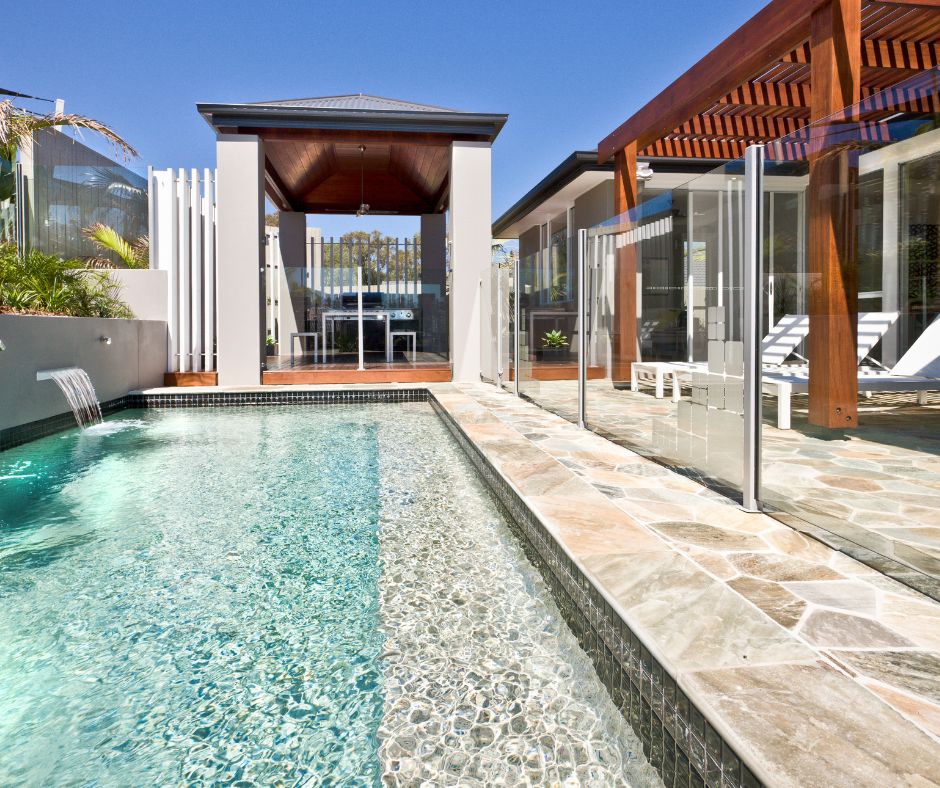
When it comes to creating an exquisite and timeless pool surround, natural stone is a popular choice among homeowners. Natural stone offers a unique blend of beauty, durability, and versatility that can elevate the aesthetics of any pool area. There are several types of natural stone to consider, each with its own distinct characteristics.
Types of Stone
- Travertine: Travertine is a type of limestone that is renowned for its natural beauty and durability. It is available in a range of colors and finishes, including tumbled, honed, and brushed. Travertine is known for its ability to stay cool under the sun, making it comfortable to walk on even in hot weather.
- Slate: Slate is a fine-grained metamorphic rock that offers a sophisticated and rustic look to pool surrounds. It is available in various colors, including gray, black, and green. Slate is appreciated for its slip-resistant surface and resistance to weathering, making it a suitable choice for both indoor and outdoor pool areas.
- Granite: Granite is a popular choice for pool surrounds due to its durability and resistance to heat and moisture. It is available in a range of colors, including black, gray, and pink. Granite features a natural sparkle and can be polished to a high sheen, adding an elegant touch to any pool area.
- Limestone: Limestone is a sedimentary rock that offers a classic and timeless appeal to pool surrounds. It is available in various colors, including beige, gray, and gold. Limestone is known for its soft and smooth texture, making it comfortable to walk on. However, it may require regular maintenance to prevent staining.
Pros and Cons of Natural Stone Pool Surrounds
Natural stone pool surrounds offer numerous benefits, but it’s important to consider the potential drawbacks as well. Here are some pros and cons to help you make an informed decision:
| Pros | Cons |
|---|---|
| Elegant and timeless: Natural stone adds a touch of sophistication to any pool area. | Higher cost: Natural stone can be more expensive compared to other materials. |
| Durable: Natural stone is known for its durability and ability to withstand harsh weather conditions. | Requires maintenance: Some types of natural stone may require regular sealing and maintenance to keep them in optimal condition. |
| Variety of options: There is a wide range of natural stone options to choose from, allowing you to find the perfect match for your aesthetic preferences. | Slippery when wet: Some types of natural stone can become slippery when wet, necessitating the use of non-slip treatments or textured finishes. |
| Heat resistance: Natural stone tends to stay cool underfoot, making it comfortable to walk on even on hot days. | Limited color options: Natural stone may have limited color options compared to other materials like concrete or tile. |
When considering natural stone for your pool surround, keep in mind the specific characteristics of each stone type, your budget, and the level of maintenance you’re willing to undertake. Consulting with a professional pool landscaper can help you make an informed decision based on your specific needs and preferences.
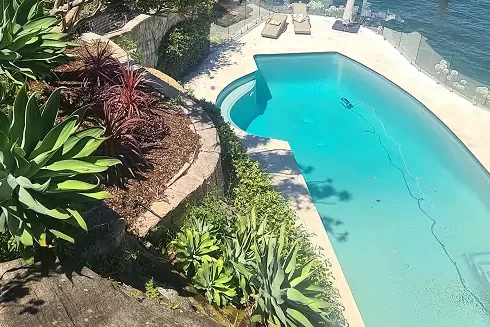
Concrete
Concrete is a versatile and popular choice for pool surrounds due to its durability and design flexibility. There are two common forms of concrete used for pool surrounds: stamped concrete and pavers.
Stamped Concrete
Stamped concrete is created by pouring concrete onto the pool area and then imprinting it with various patterns and textures to mimic the look of natural materials like stone or brick. This allows homeowners to achieve the desired aesthetic without the higher cost associated with using natural materials. Stamped concrete pool surrounds offer a range of design possibilities and can be customized to suit different styles and preferences.
One of the advantages of stamped concrete is its ability to create a unified and seamless look. With no individual pavers or tiles, there are fewer joints and seams that can potentially shift or crack over time. Additionally, stamped concrete can be sealed to enhance its durability and resistance to stains, fading, and weathering.
Concrete Pavers
Pavers are individual concrete units that interlock to form a pool surround. They come in various shapes, sizes, and finishes, allowing for endless design possibilities. Pavers provide a classic and timeless look and can be easily replaced if any damage occurs to a specific unit.
The joints between pavers allow for natural movement in extreme heat and cold, reducing the risk of structural damage. Moreover, pavers offer excellent slip resistance, making them a safe option for pool areas.
Both stamped concrete and pavers have their own set of pros and cons when used as pool surrounds. Consider the following factors when deciding on the perfect material for your pool surround:
| Factors to Consider | Stamped Concrete | Pavers |
|---|---|---|
| Cost | Lower initial cost compared to pavers | Higher initial cost due to individual units |
| Customisation | Offers a wide range of patterns and textures | Limited customisation options |
| Maintenance | Requires periodic resealing to maintain appearance and durability | Minimal maintenance required, individual pavers can be replaced if damaged |
| Installation | Faster installation process compared to pavers | Installation can be more labor-intensive |
| Durability | Durable and long-lasting with proper maintenance | Excellent durability, can withstand freeze-thaw cycles |
| Safety | Provides a smooth surface with slip-resistant sealants | Excellent slip resistance |
When choosing between stamped concrete and pavers for your pool surround, it is essential to consider your budget, desired aesthetic, maintenance preferences, and the level of customization you desire.
Remember, the ideal material for your pool surround should not only enhance the beauty of your pool area but also provide durability, safety, and functionality for years to come.
Are you wondering if pavers or decking is going to be better?
See more about the paving work we do
Timber
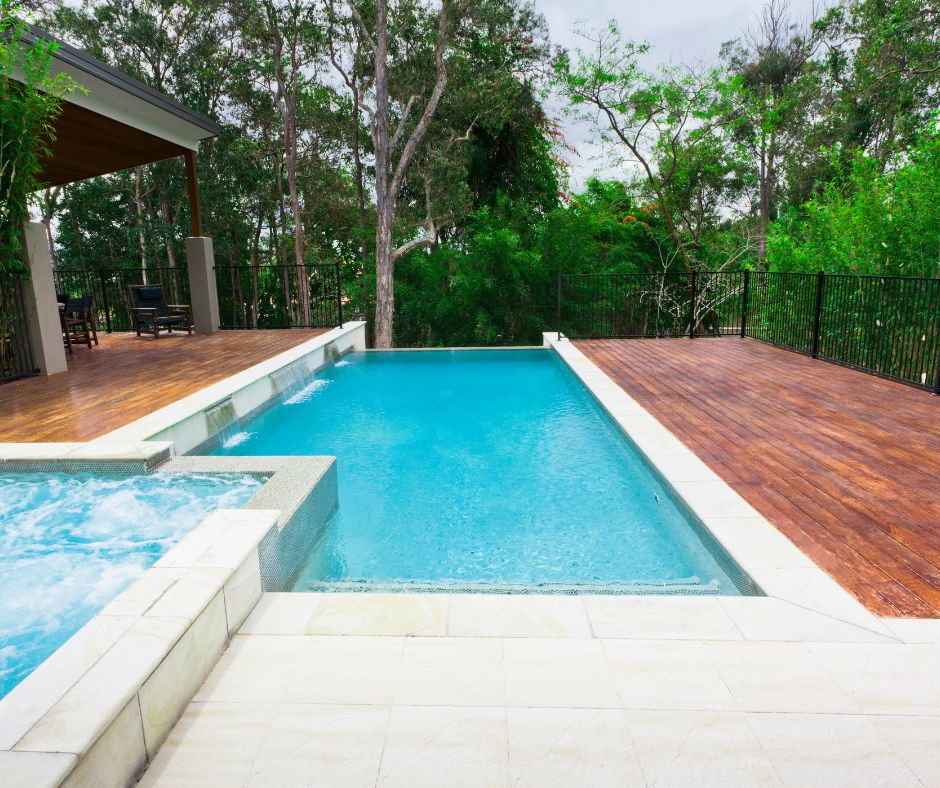
Timber is a classic and versatile choice for pool surrounds, adding warmth and natural beauty to your outdoor space. There are several types of timber commonly used for pool surrounds, each with its own unique characteristics and suitability.
3 Types of Timber We Typically Use For Pool Decks
Merbau:
Features:
- Rich, reddish-brown color with attractive grain patterns.
- High natural oil content, making it resistant to pests and decay.
- Dense and durable hardwood.
- Class 1 durability rating, ideal for outdoor applications.
Benefits:
- Excellent resistance to termites and decay, ensuring a longer lifespan.
- Naturally resistant to moisture and rot, making it suitable for pool areas.
- Low maintenance requirements, requiring minimal staining or sealing.
- Beautiful appearance adds a touch of elegance to pool decks.
Spotted Gum:
Features:
- Variable color range from pale to dark brown with unique grain patterns.
- Class 1 or 2 durability rating, depending on the species.
- Naturally fire-resistant timber.
- Hard and dense hardwood.
Benefits:
- Highly durable and resistant to decay, termites, and fungal growth.
- Suitable for pool decks due to its toughness and stability.
- Can withstand Australia’s harsh climate, including extreme temperatures.
- Minimal maintenance required, as it weathers beautifully over time.
Blackbutt:
Features:
- Light to pale brown color with a straight grain pattern.
- Class 1 durability rating, making it highly resistant to decay.
- Medium-density hardwood.
- Available in both natural and plantation-grown varieties.
Benefits:
- Excellent resistance to decay, making it ideal for pool decks.
- Less prone to surface checking and splintering compared to some other timbers.
- Sustainable plantation-grown options available.
- Easy to work with, allowing for creative designs and finishes.
When choosing the right timber for a pool deck in Australia, consider factors like durability, resistance to decay and pests, maintenance requirements, and the overall aesthetic you desire for your outdoor space. Each of these timbers has its own unique features and benefits, so make sure to select the one that best suits your needs and preferences. Additionally, proper maintenance, such as regular cleaning and sealing, will help extend the life of your pool deck regardless of the timber used.
Pros and Cons of Wood Timber Surrounds
Pros:
- Natural Aesthetic: Wood pool surrounds add a warm and inviting atmosphere to your outdoor space, creating a natural and rustic look.
- Comfortable Surface: Wood provides a comfortable surface for bare feet, as it tends to stay cooler than other materials under direct sunlight.
- Versatility: Wood can be easily customized to fit your design preferences. It can be stained or painted in various colors to match your pool area.
Cons:
- Maintenance: Wood requires regular maintenance to maintain its appearance and durability. This includes periodic sealing, staining, and protection against moisture and UV damage.
- Potential for Damage: Wood is susceptible to rot, warping, and cracking if not properly maintained. It may also be prone to splintering, which can be a concern for barefoot pool-goers.
- Cost: Depending on the type of wood chosen, the cost of wood pool surrounds can vary. Some hardwood options, such as teak, can be more expensive compared to other materials.
When considering wood for your pool surround, it’s important to weigh the pros and cons and assess your willingness to commit to regular maintenance. By choosing the right type of timber and providing proper care, you can enjoy the timeless beauty and natural appeal of a wood pool surround. See more about the decking work we do
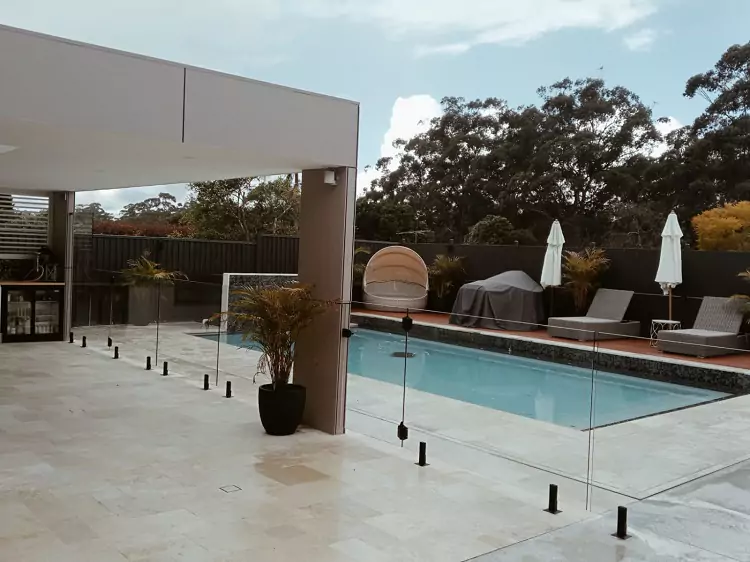
Tile
When it comes to selecting a pool surround material, tiles are a popular and versatile choice. They offer a range of options in terms of aesthetics, durability, and maintenance. Two common types of tiles used for pool surrounds are ceramic tiles and porcelain tiles.
Ceramic Tiles
Ceramic tiles are a classic choice for pool surrounds. They are available in a wide variety of colors, patterns, and textures, allowing you to create a personalized look for your pool area. Ceramic tiles are known for their affordability and ease of installation, making them a popular option for many homeowners.
One of the advantages of ceramic tiles is their resistance to water absorption. This makes them suitable for pool areas where moisture exposure is high. Additionally, ceramic tiles are relatively easy to clean and maintain, requiring little more than regular sweeping and occasional mopping. However, it’s important to note that ceramic tiles may be prone to chipping or cracking if heavy objects are dropped on them.
Porcelain Tiles
Porcelain tiles are another excellent choice for pool surrounds. They are known for their durability and strength, making them highly resistant to damage from heavy foot traffic, UV rays, and moisture. Porcelain tiles come in a wide range of colors, sizes, and finishes, allowing you to achieve a desired aesthetic for your pool area.
One of the key advantages of porcelain tiles is their low water absorption rate. This makes them highly resistant to stains, mould, and mildew, making maintenance a breeze. Porcelain tiles are also known for their slip-resistant properties, providing a safer surface for poolside areas that may be wet or slippery.
| Tile Type | Pros | Cons |
|---|---|---|
| Ceramic Tiles | Affordable, wide variety of colors and patterns, resistant to water absorption, easy to clean and maintain | Prone to chipping or cracking |
| Porcelain Tiles | Durable and strong, low water absorption rate, resistant to stains and mold, slip-resistant | Relatively more expensive |
When considering tile options for your pool surround, it’s essential to choose tiles that are specifically designed for outdoor use and are resistant to fading from UV exposure. It’s also recommended to work with a professional pool landscaper to ensure proper installation and to select tiles that complement your overall pool design.
By exploring the benefits and considerations of ceramic and porcelain tiles, you can make an informed decision when selecting the perfect tile material for your pool surround. Remember to consider factors such as budget, maintenance requirements, and aesthetic preferences to create a pool area that is both stylish and functional.
Other Materials to Consider
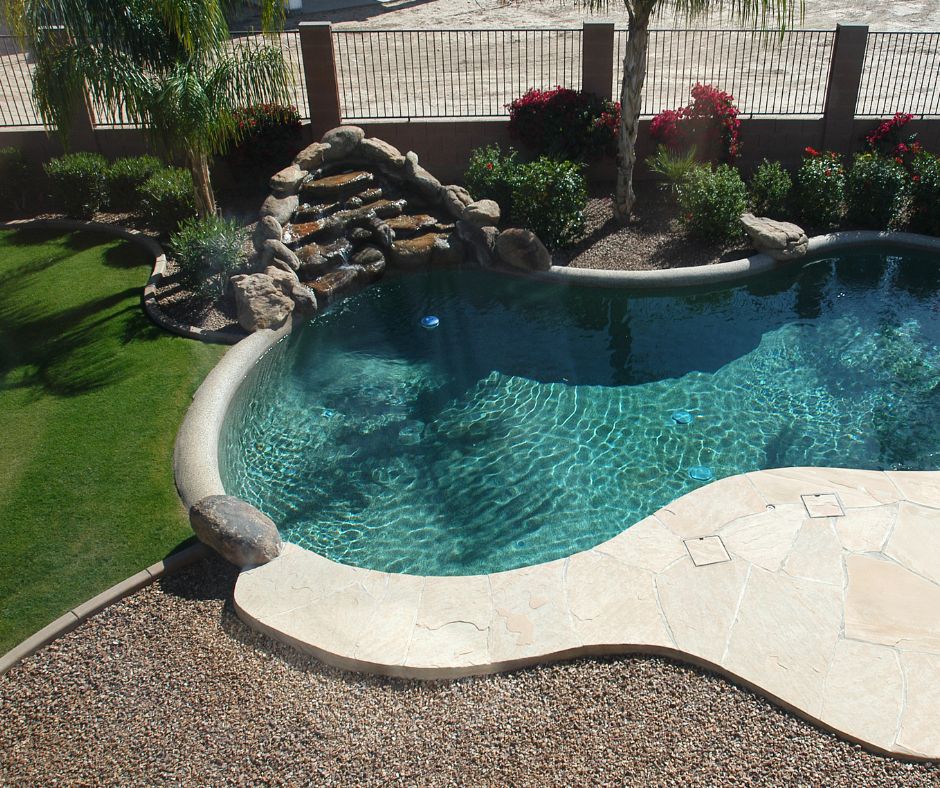
In addition to the traditional options like natural stone, concrete, wood, and tile, there are a few alternative materials that homeowners can consider for their pool surrounds. These materials offer unique characteristics and can create a distinctive look for your pool area. Two popular alternatives are rubber and composite materials.
Rubber
Rubber pool surrounds provide a soft and comfortable surface for pool areas. They are often made from recycled rubber materials, making them an environmentally friendly option. Rubber pool surrounds offer excellent slip resistance, making them a safe choice for wet areas. They also have a cushioning effect, which can be more forgiving on joints and provide a more comfortable walking surface.
One of the advantages of rubber pool surrounds is their low maintenance requirements. They are resistant to UV radiation, chlorine, and other pool chemicals, which helps to prevent fading and damage. Rubber pool surrounds are available in various colors and patterns, allowing for customization to match your preferred aesthetic.
Artificial Turf
Artificial Turf is another alternative for pool surrounds. It offers the natural look of a grassed area around the pool but without the maintenance of a lawn to care for. It has but with enhanced durability and resistance to moisture, rot, and insects.
Artificial Turf is known for it’s longevity and low maintenance requirements. It does not require maintenance but it can get very hot under foot if in direct sunlight.
Below is a summary of the pros and cons of these alternative pool surround materials:
| Material | Pros | Cons |
|---|---|---|
| Rubber | – Slip-resistant surface – Cushioning effect – Low maintenance requirements | – Limited design options – May fade over time |
| Artificial turf | – Natural look with enhanced durability – Resistance to moisture, rot, and insects – Low maintenance requirements | – Higher initial cost – Gets hot |
When considering alternative pool surround materials, it’s important to assess their suitability for your specific needs and preferences. Each material has its own set of advantages and limitations, so take into account factors such as budget, desired aesthetics, maintenance requirements, and durability.
To explore more options and learn about the traditional materials like natural stone, concrete, wood, and tile, refer to the respective sections in this article.
Get in touch with us at Oasis Landscaping Projects if you would like more help with creating a new pool surround OR renovating the existing pool surround you have.
We are experienced Sydney Pool Landscapers, who can provide expert advice tailored to your specific pool area.

